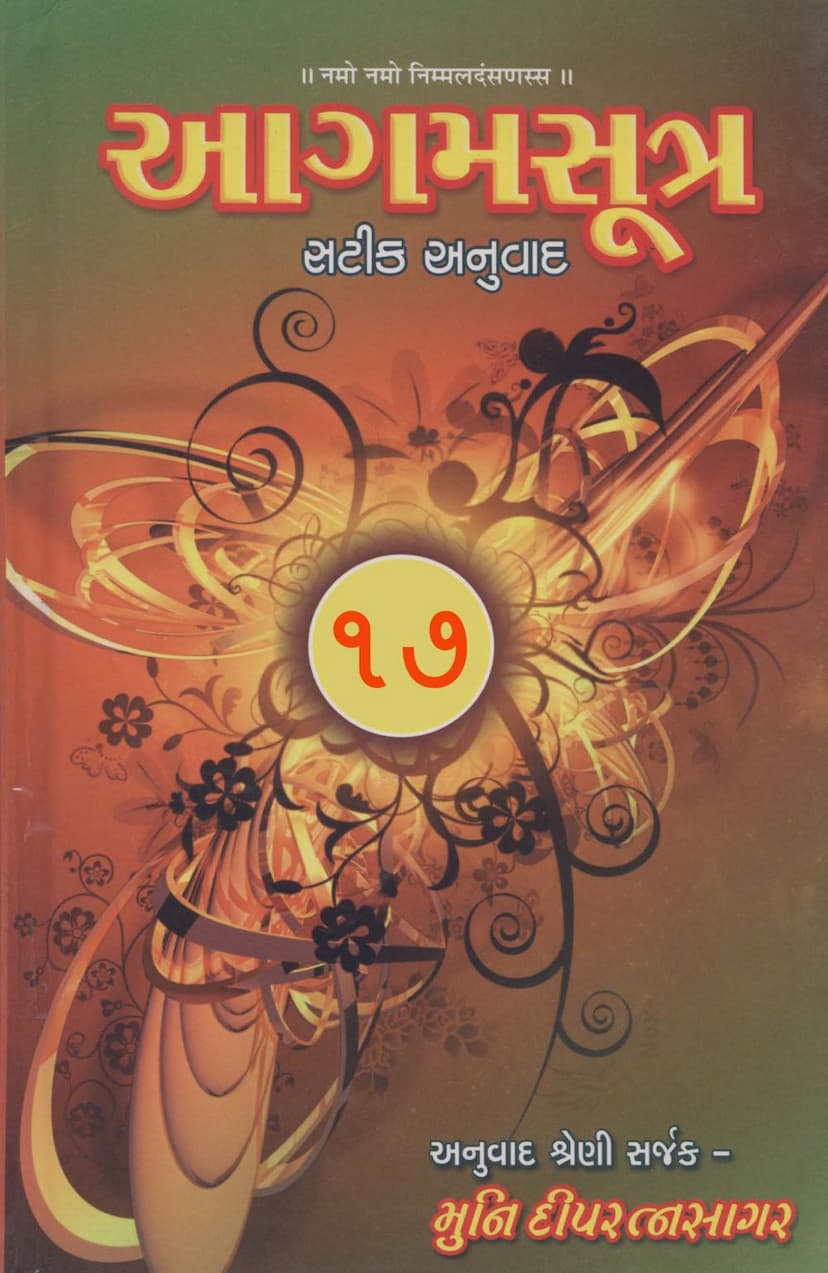Agam 13 Raipasaneiya Sutra Satik Gujarati Anuvad
Added to library: September 1, 2025

Summary
This document is the Gujarati commentary and translation of Agam 13, the Rāyapasaneiya Sūtra, which is an Upanga Sūtra of Jainism. It is part of a larger series titled "Agam Satik Anuvad" (Commented Translation of Agams) by Muni Dippratnasagar, published by Deepratnasagar.
Here's a breakdown of the provided text, focusing on the content relevant to the summary:
1. Title and Authorship:
- Book Title: Agam 13 Rāyapasaneiya Sutra Satik Gujarati Anuvad (આગમ ૧૩ રાયપાસણીય સૂત્ર સટીક ગુજરાતી અનુવાદ)
- Author/Translator: Muni Dippratnasagar (મુનિ દીપરત્નસાગર)
- Publisher: Deepratnasagar (દીપપ્રત્નસાગર)
- Series: Agam Satik Anuvad Shreni (આગમ સટીક અનુવાદ શ્રેણી)
2. Introduction to the Sūtra:
- Agam Number: 13
- Upanga: Rāyapasaneiya (રાયપાસણીય)
- Alternate Names: In Prakrit, it's known as Rāyaṇāya (રાયણાય), and in Sanskrit, as Prapnaprācarana (પ્રશ્નપ્રકરણ) or Jivābhigama (જીવાભિગમ). The title Jivābhigama is particularly prevalent in practical use and refers to the study of the soul.
- Content Focus: The text highlights that this Upanga is rich in Kathānuyoga (narrative discourse), particularly featuring the story of King Pradeshi and detailed descriptions of Subhadeva. While it doesn't have formal divisions like Shrutskandhas or Adhyayanas, it extensively discusses the soul (Jiva) and its existence (Astitva) through Dravyānuyoga (substance discourse), illuminating Jain philosophical tenets like the six substances (Jivadi Tattvas). It also touches upon Charana-Karaṇānuyoga (conduct and action discourse) through topics like Vandana and Paushadha.
3. Explanation of the Title "Rāyapasaneiya":
- The title "Rāyapasaneiya" is derived from the questions posed by King Pradeshi to the revered Shramana Keshi Kumar Shraman. The answers given by Keshi Kumar Shraman, which led to his enlightenment and subsequent celestial rebirth as the chief of a Vimana, form the core of this Upanga. The term "Rāyapasaneiya" refers to these royal inquiries.
4. Commentary and Translation:
- The translation is based on the commentary (Vritti) of Acharya Malayagiri (પૂ. મલયગિરિજી), a respected commentator in Jain tradition. The text also mentions the existence of Chūrṇi and Laghuvritti for Jivābhigama, although the Chūrṇi is not known to be published. The current translation relies solely on the Vritti.
5. Key Themes and Narratives:
- King Pradeshi and Keshi Kumar Shraman: The primary narrative revolves around the philosophical discussions between King Pradeshi and Keshi Kumar Shraman, a Gandhara (chief disciple of Mahavir Swami). The king, initially influenced by incorrect doctrines, poses questions about the soul and Jain principles.
- The King's Transformation: Keshi Kumar Shraman's answers lead King Pradeshi to attain right faith (Samyak Darshana). This knowledge also influences his destiny in future lives.
- Deva Suryābha: A significant portion of the text details the celestial experiences and rituals of Deva Suryābha. This includes the description of his Vimana, his celestial retinue, his interactions with Lord Mahavir, and the elaborate artistic and sensory descriptions of his divine abode.
- Moral and Philosophical Instruction: The text uses these narratives to illustrate Jain teachings on karma, soul, liberation, the nature of reality, and ethical conduct.
- Detailed Descriptions: The commentary provides extremely detailed, almost exhaustive, descriptions of celestial palaces, gardens, divine vehicles (Vimanas), musical instruments, dances, and the physical attributes of celestial beings. This level of detail serves to illustrate the grandeur and perfection of the Jain cosmology.
- The Question of the Soul: A central theme is the philosophical debate about the nature of the soul, its distinctness from the body, and its eternal nature, as explained by Keshi Kumar Shraman to King Pradeshi.
6. Publication Details:
- The text includes extensive acknowledgments to various donors and supporters (Dravya Sahayakas) who contributed to the publication of this commentary series. This highlights the significant effort and resources involved in making these Jain scriptures accessible.
- It also lists other publications by the same author/publisher, covering various aspects of Jain literature like original Agams, Gujarati translations, commentaries, dictionaries, and ritualistic texts. This indicates a comprehensive effort to preserve and disseminate Jain knowledge.
In essence, the provided text is the Gujarati translation and commentary of the Rāyapasaneiya Sūtra, which is a foundational Jain scripture. It details profound philosophical discussions, particularly between King Pradeshi and Keshi Kumar Shraman, exploring the nature of the soul and the path to liberation. It also offers vivid and detailed descriptions of celestial realms and beings, illustrating the Jain worldview.